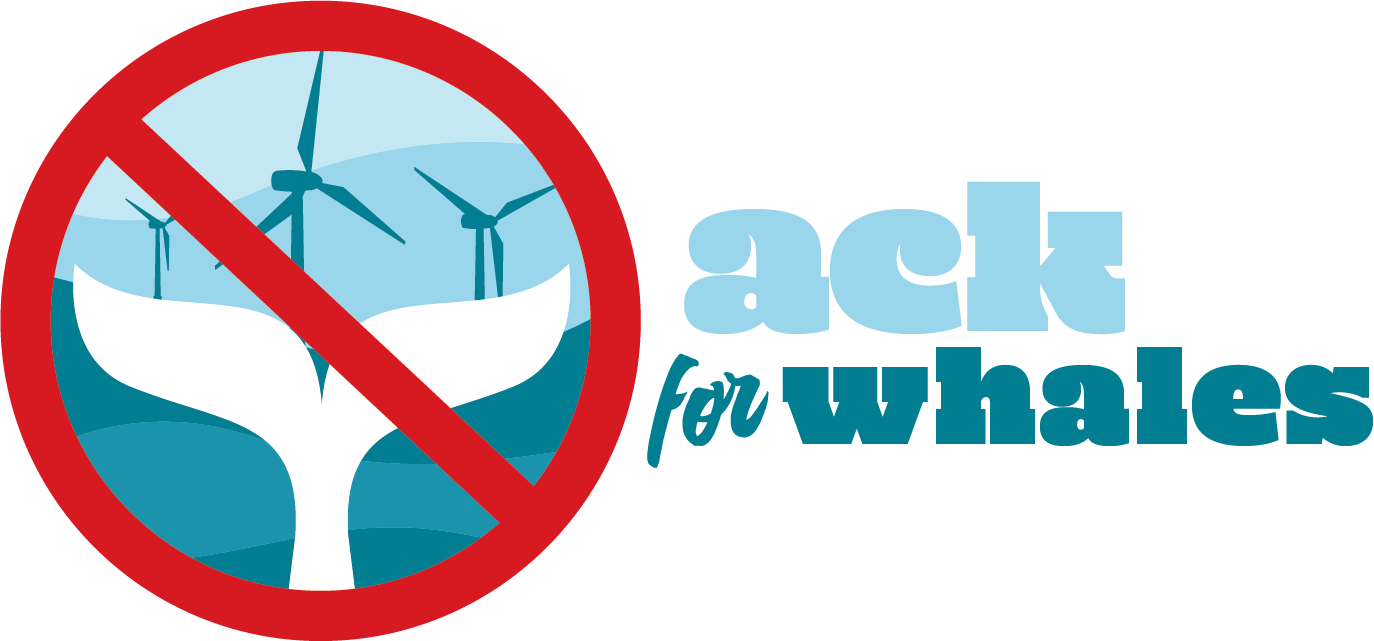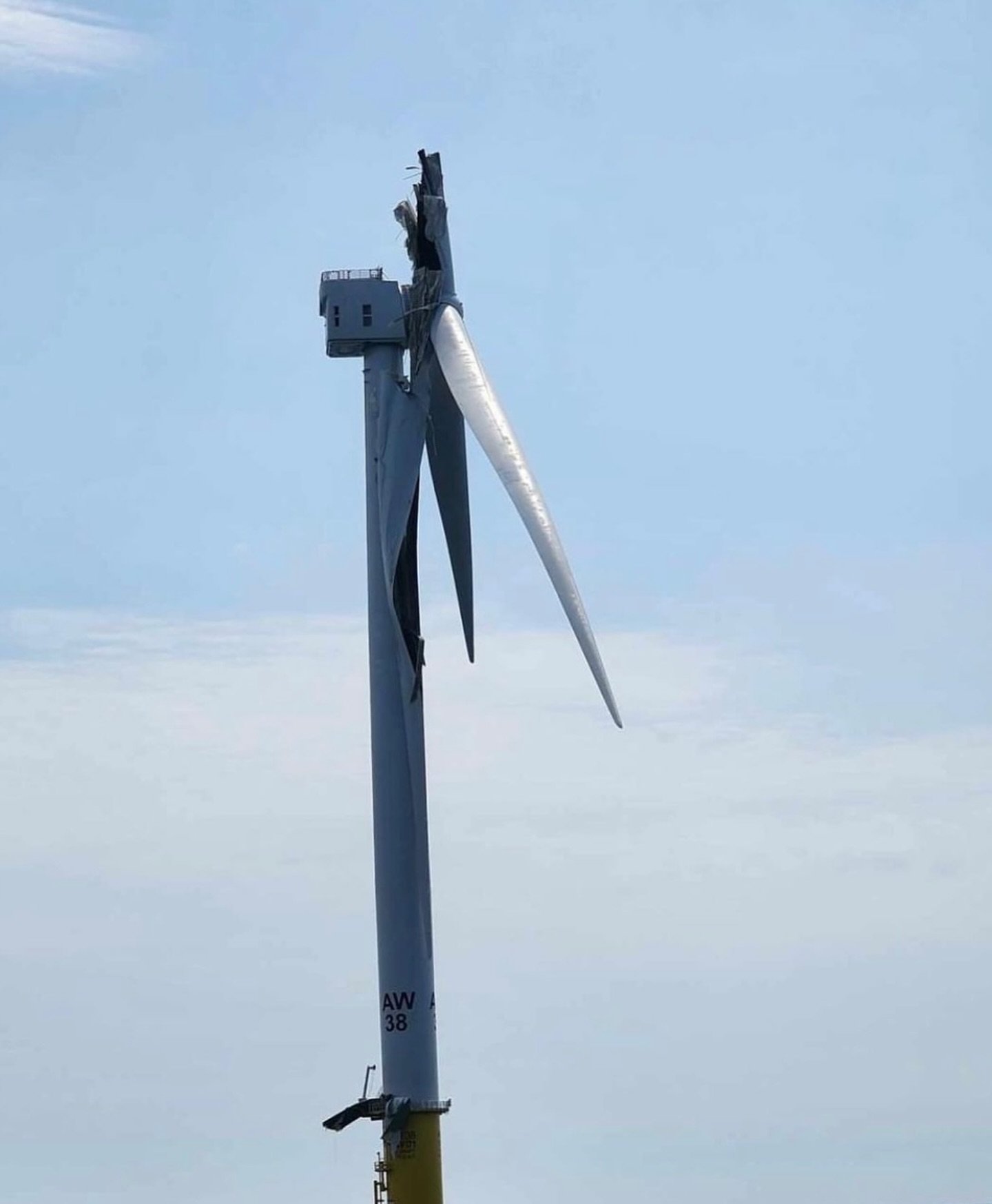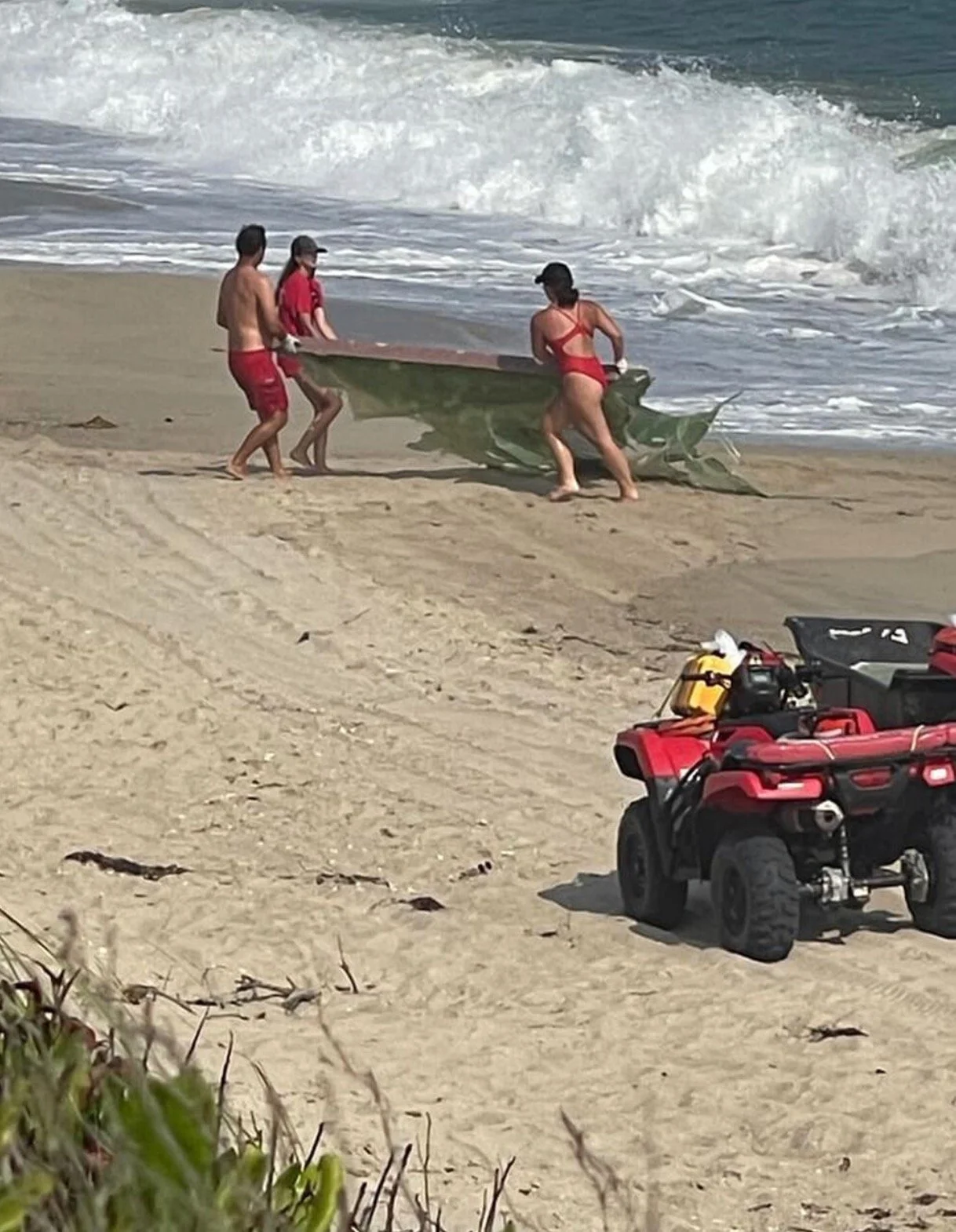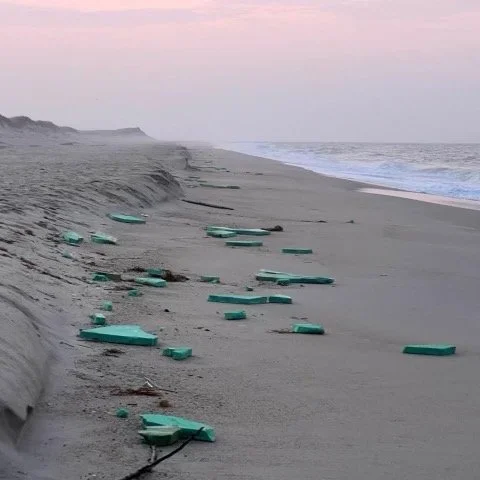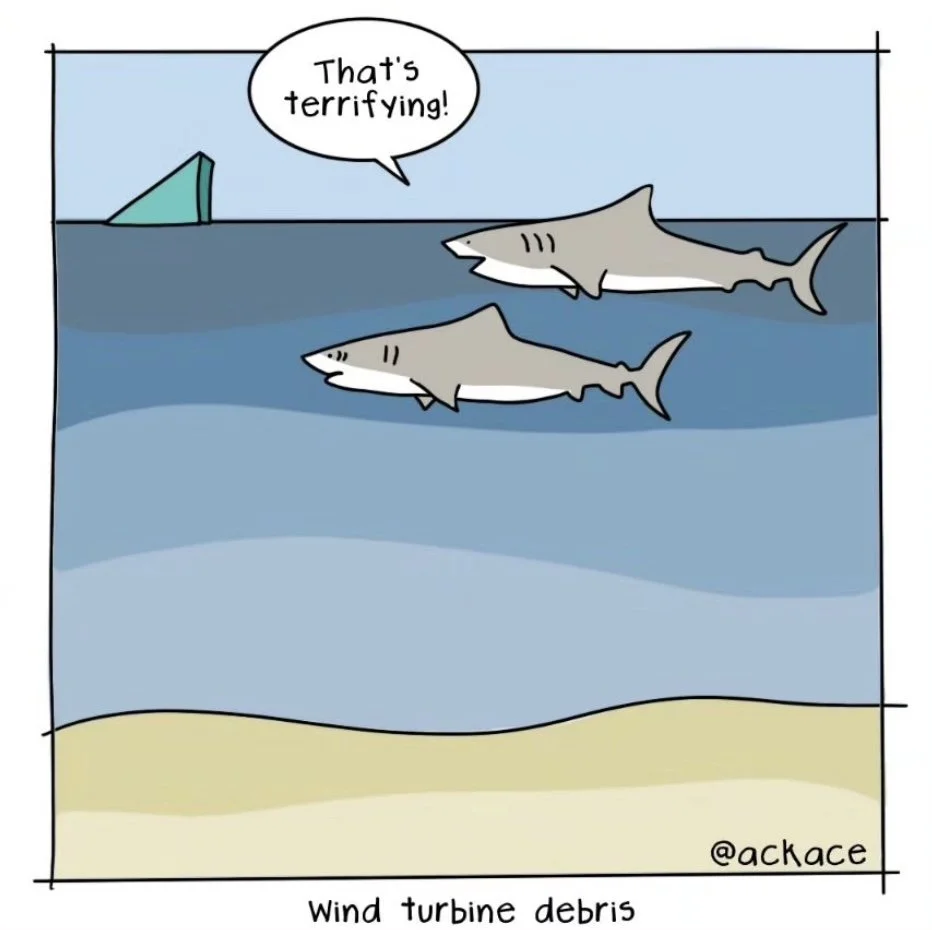
Catastrophic Blade Failure
July 13, 2024
Summary of Vineyard Wind Blade Failure and Resumption of Blade Installation as of April 17, 2025:
Revised Construction and Operating Plan approval should be rescinded immediately.
The Vineyard Wind 1 offshore project is not ready for prime-time, and neither is the BOEM permitting team or the Bureau of Safety and Environmental Enforcement(BSEE). Vineyard Wind 1 has been a poster child for how political whims can create disastrous energy policy since its early development. Yet as recently as April 16, 2025, the company reports over 35 vessels actively working on its construction and dozens of untested 70-ton blades sit at the New Bedford, MA terminal waiting to be installed.
Background:
In the final days of the previous Trump Administration, it seemed unlikely that the Vineyard Wind 1 project would get a favorable “Record of Decision” on January 15, 2021 as hoped. On December 1, 2020, Vineyard Wind announced that it was temporarily withdrawing its Construction and Operation Plan (COP) for the Vineyard Wind I project to complete necessary due diligence associated with the announcement that the project would be utilizing new industry-leading wind turbine generators from U.S. based General Electric (GE Vernova). The short pause was to allow the project team to conduct a final technical review associated with the inclusion of GE’s 13 MW Haliade-X into the final project design. Until that time, the plan was to use Vestas 9.5 MW turbines. This withdrawal of the application, combined with the reason of using a newer turbine model, would place the decision making with the new Biden administration later in 2021.
In January of 2021, through Executive Order #14008, the Biden administration made clear its goal of producing 30 gigawatts of offshore wind power by 2030 and that it would use an “all of government approach” to make that happen. At every turn, it seemed the rush to build unreliable and expensive gigawatts was put ahead of proper analytics, testing and science. Questions about untested equipment, cumulative impacts to marine life from multiple industrial scale projects being built concurrently, and the readiness of grid connections were all tossed aside in favor of rushed permitting that would secure foreign developers lucrative US tax credits.
How was the blade design approved?
The Haliade -X blades were the longest ever tested at facilities designed to test blades for various stresses. GE tested the blades’ design in Massachusetts in 2019 at the state’s wind technology testing center, which sits along the Mystic River in Boston. Due to its size, engineers had to remove the tip of the blade, as the 351-foot model was too long to fit in the 295-foot testing facility. These blades are among the largest composite structures in the world – the fact that production and testing were both rushed, and incomplete is inexcusable.
BOEM’s long list of approved departures from the renewable energy regulations includes the eyebrow-raising approval of Vineyard Wind’s request to shortcut the review of design, fabrication, and installation reports.
Contrary to the regulations, Vineyard Wind was authorized to begin the fabrication of facilities before BOEM “received and offered no objections to their Facility Design Report (FDR) and Fabrication and Installation Report (FIR).”
“Vineyard Wind requests a regulatory departure from §585.700(b) requiring that fabrication of approved facilities not begin until BOEM provides notification that it has received and has no objections to the submitted Facility Design Report (FDR) and Fabrication and Installation Report (FIR)”. Allowing these fabrication activities to take place earlier in time would allow Vineyard Wind to adhere to its construction schedule, maintain its qualification for the Federal Investment Tax Credit, and meet its contractual obligations under the Power Purchase Agreements with Massachusetts distribution companies.[1]
This concern, along with the division of responsibilities between BOEM and BSEE, should be part of the Vineyard Wind investigation.
GE introduced the large Haliade-X to the world in early 2018. Its selling point was its significant power advantage, in part due to its size. Its 351-foot blade length produced 45% more energy than other market models at the time.
Because of this power capacity, Vineyard Wind could use fewer turbines to satisfy utility contracts: 62 turbines instead of a potential 100. But nowhere in any of the project documents is the lack of product testing and increased risk mentioned. In fact, “blade failure” is never mentioned and lightning strikes get only a cursory mention.
[1] https://budsoffshoreenergy.com/2024/08/06/boem-waived-fabrication-report-requirement-so-
Catastrophic Blade Failure:
On Saturday, July 13, 2024 a newly installed turbine (the 24th of 62 planned turbines) at the Vineyard Wind project started undergoing routine testing before it could send power to the grid. It had been operating for six hours when an alarm sounded at 4:21 p.m., signaling a “high vibration” on blade 1, and prompting a turbine shutdown.
About one hour later, a helicopter team got eyes on the cause of that vibration: one of the 350-foot blades had snapped, an incident that would send 70 tons of fragments of foam and fiberglass into the ocean and onto beaches for weeks to come. (It would be Monday, July 15 before local authorities in affected communities such as Nantucket were notified of the disaster.)
The blade failure was not the first broken blade for this blade model. Nor was it the last broken blade for the Haliade-X, manufactured by GE Vernova. Several weeks earlier, at Dogger Bank Wind Farm off England in the North Sea, a blade had failed due to an “installation error.” Weeks later, another blade failed at Dogger Bank. The company has said all three breaks were unrelated.
Debris and Immediate Environmental Impact:
Debris from the broken Vineyard Wind turbine blade washed-up all-over Nantucket's south shore beginning Tuesday morning, July 16th.
Residents began reporting pieces of green and white foam, along with larger pieces of what appeared to be fiberglass, along southern Nantucket beaches at daybreak, stretching from Madaket on the west side of the island to Nobadeer towards the southeast side.
All south shore beaches were closed to swimming by the town just after 11 a.m. on Tuesday in the height of summer tourism because of the massive amounts of debris washing ashore. The Nantucket Harbormaster stated:
"The water is closed to swimming on all south shore beaches, due to large floating debris and sharp fiberglass shards. You can walk on the beaches; however, we strongly recommend you wear footwear due to sharp, fiberglass shards and debris on the beaches.” Pets were also advised to be kept away from the beaches because of the debris.
Small business’s such as surf schools had to shut down for days as concerns mounted about fiberglass pieces in the ocean that could cause injury from cuts, ingestion and damage to eyes. Every day in the summer is critical for the survival of seasonal businesses.
A fishing charter captain out of Nantucket was in the Vineyard Wind lease area on Sunday July 14 and he noticed a significant amount and large pieces of debris. The captain noticed “big sheets of fiberglass with foam core and lots of loose foam.” Many captains expressed concern about the dangers of debris in the water that they had not been warned about and that was difficult to spot in the dark.
In the days after the incident, it was reported that a 300-foot section of the damaged blade fell into the water and sank to the ocean floor. Cleanup efforts were initiated at sea and on land.
Nantucket officials expressed concerns about the debris being characterized as "nontoxic" and the town of Nantucket began developing a water quality testing plan and a claims process. Some debris from the 70-ton blade was found as far away as Westport, MA, and Little Compton, RI
The federal Bureau of Safety and Environmental Enforcement announced that Vineyard Wind's "operations are shut down until further notice." A “root cause analysis was begun, and initial efforts were made to assess environmental impacts.
Why did the blade fail?
The failure of the Vineyard Wind turbine blade has been primarily attributed to a manufacturing defect, specifically "insufficient bonding" during the blade's construction. This means there was not enough adhesive applied to properly bond the composite materials together, leading to structural weakness.
Here's a breakdown of the factors contributing to the failure:
Insufficient Bonding: The primary cause of the blade failure was a lack of sufficient adhesive to bond the blade's composite materials. This was determined to be a manufacturing defect that should have been identified during quality control.
Manufacturing Process: The blades are made from fiberglass, balsa wood, polyethylene foam, carbon fiber, gel coating, epoxy paint, resins, and adhesive pastes. The process involves multiple steps, each of which can introduce errors if not performed precisely. Workers line individual sheets inside special molds, then cover them with foil, pump out the air to create a vacuum, and inject a resin to fuse the layers. The mold acts like a hot plate, reaching more than 150 degrees Fahrenheit. It can take up to 2,000 labor hours to produce one blade. The many "touches" in the process can introduce errors that require precise quality testing.
Quality Control Issues: The manufacturing defect was specifically a failure of quality control at the LM Wind Power factory in Gaspé, Quebec, where the blade was manufactured. In November of 2024, GE Vernova revealed a data falsification scheme" at its blade manufacturing plant in Gaspé, Canada.Managers at the LM Wind plant may have falsified quality testing data, favoring quantity over quality, according to an October, 2024 report from Canadian outlet Radio Gaspésie. The company terminated nine managers and suspended 11 floor workers as a result of the blade failure.
Blade Design: The failed blade was part of a 13-megawatt Haliade-X turbine, which is among the largest composite structures in the world. These large blades are designed to flex under rotation to reduce stress, but the design did not include reinforcing carbon fiber. One theory suggested that a torsional divergence occurred, where aerodynamic forces increased until the blade's endurance limit was met. “As offshore wind blades increase in size the primary failure mechanisms can change or may be exacerbated,” reads a 2024 paper by Paquette and several scientists at Sandia and the National Renewable Energy Laboratory. “The time to market and speed with which wind blades are changing size mean that there is no historical data to effectively analyze failure rates and failure modes.[1]”
Testing Limitations: Although a prototype of the Haliade-X blade was tested at the Massachusetts Clean Energy Center, the facility was too small to accommodate the full 351-foot blade, requiring the tip to be cut off.[2] This may have affected the test results as engineers had to extrapolate the data, and no torsion test was done on the entire blade.
Lack of Historical Data: As offshore wind blades increase in size, there is limited historical data to effectively analyze failure rates and modes.
What independent analysis of the blade failure has been conducted?
Despite BSEE’s commitment to conduct an independent analysis of the cause of the blade failure, there are no records of BSEE having conducted an independent "Root Cause Analysis”. A FOIA response states "After a thorough search of our files, it has been determined the BSEE has no records responsive to a request for either a draft or final investigation or a root cause analysis."
In an email on April 1, 2025, the FOIA administrator explained:
"The investigation is ongoing; we do not release records related to investigation until complete and these are withheld under Exemption 7(a) and 7(c) of the FOIA. If you would like, you could periodically email me to inquire whether the investigation has been completed and resubmit your request at that time."
What about the Future of the Haliade-X?
The 13-megawatt Haliade-X blade is being used in only two projects — Vineyard Wind and Dogger Bank — and its future is unclear. As of this fall, the Haliade-X, once billed as the world’s most powerful turbine, is not contracted for any other offshore wind projects. GE Vernova has signaled publicly that it seeks to exit or limit its involvement in the offshore wind business. This raises major concerns about there not being a company to stand behind its product or have the capability to participate in operations and maintenance of its product.
[1] https://www.energy.gov/sites/default/files/2024-05/operations-maintenance-roadmap-us-offshore-wind.pdf?utm_medium=email&utm_source=govdelivery
[2] https://commonwealthbeacon.org/energy/as-blades-get-longer-charlestown-testing-center-seeks-to-expand/
What about the environmental impact of the blade debris in the Ocean?
In September of 2024, BSEE announced it was requiring GE Vernova and Vineyard Wind to conduct a broad study to understand the breadth of the environmental impact from the 70 ton blade explosion. The study should characterize the subsea debris field resulting from the blade failure and potential impacts or damage to onshore, coastal, and offshore resources from the blade debris.
The study plan must include (at a minimum):
1. Clearly stated, specific objectives for the study and a technically sound basis for the timing, location, and frequency of all proposed sampling activities included in the study.
2. A detailed sampling plan, including methods, media, biota to sample, sample numbers, data analysis plans, quality assurance and quality control, potential indicator compounds, etc. This sampling plan must also include the environmental sampling Vineyard Wind 1 is undertaking in response to requests from the Commonwealth of Massachusetts and the Town of Nantucket.
3. A characterization of the subsea marine debris field that clearly identifies the location and the amount of debris on the seafloor and in coastal areas where debris was retrieved.
4. The mass balance of unrecovered debris material based on the weight of debris recovered to date and the weight of the subsea debris once retrieved.
5. A communication plan for providing BSEE updates on the status of the study.
6. The format of the results from the study.
7. The timeline for submission of the study to BSEE.
Although the study plan was due on October 11, 2024. All of the questions in the study requirement remain unanswered. Vineyard Wind did submit a plan to conduct an environmental study. This has yet to be approved by BSEE and it is unclear if revisions to the study have been requested and revised plans submitted.
A response to a FOIA request states:
"BSEE does not have responsive records for results of the study. For the first portion of your request, the Environmental Plan, we are withholding one document containing 151 pages in full under Exemption 4 5 U.S.C. § 552(b)(4). Exemption 4 protects “trade secrets and commercial or financial information obtained from a person [that is] privileged or confidential.” In conversations with the FOIA administrator on April 1, 2025, it was explained that the redacted document is the "study plan" and that there are no records of a revised or approved "study plan". It is clear the study has not commenced.
When BSEE lifted its suspension order on Vineyard Wind it reiterated the requirement for an environmental study to be conducted by the developer. In the January 17, 2025 letter to Vineyard Wind lifting the suspension order BSEE states:
"The BSEE Director also issued an Order on September 27, 2024, requiring a site-specific study plan to analyze potential environmental harm and damage from the blade failure. This Director's Order remains in effect. Under the terms of that Order, VW1 must submit a study plan to BSEE and then conduct the site-specific study. The study will assess any impacts of the blade failure, although the results of the study are meant to provide information about the environmental impacts of the blade failure over an extended timeframe. The results of the study may be used to inform future environmental analyses, as well as mitigation and monitoring, where applicable."
Have the questions from the public regarding the blade failure been answered by BSEE?
The public at large on Nantucket has had significant concerns go unanswered since the July 13, 2024, Blade failure. After months of requests, BSEE finally agreed to take written public questions and address them at a Zoom meeting on January 4, 2025. Despite announcing the meeting on December 24, 2024, and only allowing 1 week for questions to be submitted, BSEE received hundreds of questions from the public. The meeting was postponed to February 3, 2025, due the volume of questions and then indefinitely cancelled.
Neither the broad set of questions submitted by the public or the answers to them were ever shared with the public. In addition, BOEM chose not to include a public comment period to the revised Construction and Operating Plan for the project.
Not only was public comment not included in the approval process, but there was also no mention to the public that the revised documents had been submitted and were being reviewed until the approval announcement was made in a January 18, 2025, press release. There was no formal announcement made to the interested parties who had submitted questions to BSEE for their canceled January 4, 2025, meeting. And there is no mention of the revised documents or approval in the Federal Register.
Blade installation is allowed to continue – despite lack of testing of an intact full-sized blade:
The key conditions under which blade installation can resume include:
Removal of faulty blades: Vineyard Wind is required to remove all installed blades that were manufactured at the GE Vernova plant in Gaspé, Canada, where the blade that failed was produced due to a "manufacturing deviation" involving insufficient bonding. This could involve removing blades from a maximum of 22 wind turbine generators (66 blades).
No new Gaspé blades: BSEE will not permit the installation of any new blades manufactured at the Gaspé facility.
Demonstrating the integrity of new blades: Vineyard Wind and GE Vernova must demonstrate that newly manufactured blades (likely from the Cherbourg, France facility) meet the original design criteria. This includes ensuring the wind turbine generator is fit for service with redundant power and that the blade monitoring system is functioning correctly to shut down the turbine if blade damage occurs.
Witnessed manufacturing: A certified verification agent must witness the manufacturing process for all newly produced blades at the Cherbourg facility, with specific attention to the application of adhesive and blade closure, aligning with BSEE's requirements.
Post-installation inspections: External inspections of newly installed blades are required within six months via drone or rope access.
Potential removal of Cherbourg blades: If Vineyard Wind cannot satisfactorily demonstrate that the Cherbourg-manufactured blades meet the original design criteria after any necessary repairs, BSEE may require their removal as well.
Prior to the full lifting of the suspension, BSEE had allowed some "specific activities" on a "case-by-case basis", and by December 2024, one set of blades had been re-installed. As of January 18, 2025, a single turbine with blades from the Cherbourg facility was generating power. (hopefully this is not an attempt to realize investment tax credits) The resumption of broader blade installation is now proceeding under the conditions set forth by BSEE in the revised construction and operations plan.
Outrageously, the damaged turbine, AW38, was not prioritized for blade removal despite it being compromised, and without lighting protection during the harsh winter months:
***Further evidence of the inadequacies of the revised COP were revealed when a Vineyard Wind turbine (AW-38) was struck by lightning in late February 2025!***
Turbine AW38 was struck by lightning on February 28th and sustained further damage from fire, putting the two remaining (70-ton) blades at further risk of failure.
This event also revealed that there is still no adequate communication or pollution response plan for such highly probable events.
Conflicting reports initially placed the lightning strike on either Thursday, February 27th, or Friday, February 28th. However, BSEE later stated that the strike occurred on Friday, February 28th.
At the time of the lightning strike, the nub of the damaged blade remained attached to the turbine rotor.
Vineyard Wind's Assessment: Vineyard Wind reported preliminary evidence indicating a lightning strike but continued to assess in coordination with GE Vernova. They stated there was "no indication of debris" and "no impact to the nacelle or turbine structure". They deployed aerial and maritime resources for inspection.
Coast Guard's Confirmation: The Coast Guard confirmed a lightning strike occurred on Friday, February 28th, but could not confirm fire or further detachment of blade debris. They were informed by Vineyard Wind of no debris but did not independently confirm this.
Non-Operational Lightning Protection: The turbine's lightning protection system was not operational due to the blade failure it suffered in July 2024, according to BSEE. All other Vineyard Wind turbines were equipped with lightning protection.
Lack of Immediate Notification to Nantucket: The Town of Nantucket was not informed about the lightning strike until Sunday afternoon, March 2nd, approximately three days after the reported incident. This delay in notification was criticized by the Select Board as "unacceptable". Select Board chair Brooke Mohr expressed "total disbelief" at the lack of timely communication. The delayed notification of the lightning strike to the Town of Nantucket mirrored the communication issues following the initial blade failure, raising further concerns among local officials and residents regarding Vineyard Wind's communication protocols.
BSEE's Response: BSEE stated they were overseeing the assessment and response to the lightning strike and required Vineyard Wind to conduct a "comprehensive assessment" to determine the extent of the damage. Vineyard Wind stated no initial debris was found by overflights and on-scene vessels. There is no indication that BSEE independently verified any of this.
Photos of Vineyard Wind Turbine AW 38 before and after lightning strike.
What is the issue with the BSEE:
BSEE is under pressure to demonstrate its effectiveness in regulating the offshore wind industry, particularly regarding safety, transparency, and communication with stakeholders. The agency's handling of the Vineyard Wind blade failure has raised questions about its preparedness for the unique challenges of this relatively new industry and whether it can balance safety, environmental protection, and the rapid development of renewable energy projects.
Lack of Transparency and Communication:
BSEE is relatively new to regulating offshore wind, having primarily focused on the oil and gas industry. This has led to questions about its ability to effectively oversee the developing offshore wind industry.
BSEE is responsible for regulatory oversight and enforcement of environmental compliance, inspections, and investigations, while BOEM studies the environment and leases resources. The division of responsibilities between BOEM and BSEE can sometimes be unclear.
There are concerns about whether BSEE is adequately ensuring safety and environmental protection in offshore wind projects. The agency does not have its own vessels and usually relies on developers for transportation to offshore wind projects.
BSEE has been criticized for a lack of communication with local and state officials, as well as the public, regarding the Vineyard Wind blade failure. For example, Nantucket officials were not notified by BSEE of the July 13, 2024 blade failure incident. This misstep was repeated in February of 2025 when the SAME turbine (AW38) was struck by lightning and caught fire while still having 2 defective blades attached.
The agency's repeated delay in notifying local stakeholders is irresponsible with regard to public safety.
BSEE has not been transparent about its investigation into the blade failure and has not released its findings to the public.
BSEE's suspension orders and other regulatory actions have not always been made public.
BSEE publicly states it is requiring Vineyard Wind to complete an environmental impact study regarding the blade failure. No study parameters or results have been made public.
A newly released report by the independent Government Accountability Office makes clear that BSEE is not prepared to offer proper oversight of the Vineyard Wind project. The lack of investigation and reporting on the blade failure underscores this deficiency. BOEM should not have approved the revised COP until BSEE concluded its investigation and enforced its order for the developer to analyze the environmental impacts of the catastrophic blade that occurred over 9 months ago. GAO Report
Vineyard Wind Project should be immediately halted:
The Vineyard Wind project continues to pose a threat to public and environmental safety. The systems are simply not in place to enforce project conditions, communicate with stakeholders and to monitor for environmental harms.
There are no benefits to the environment, the economy, or to the public at large. It is simply irresponsible for this project to continue. Our federal resources should be redirected to energy projects that make sense.
